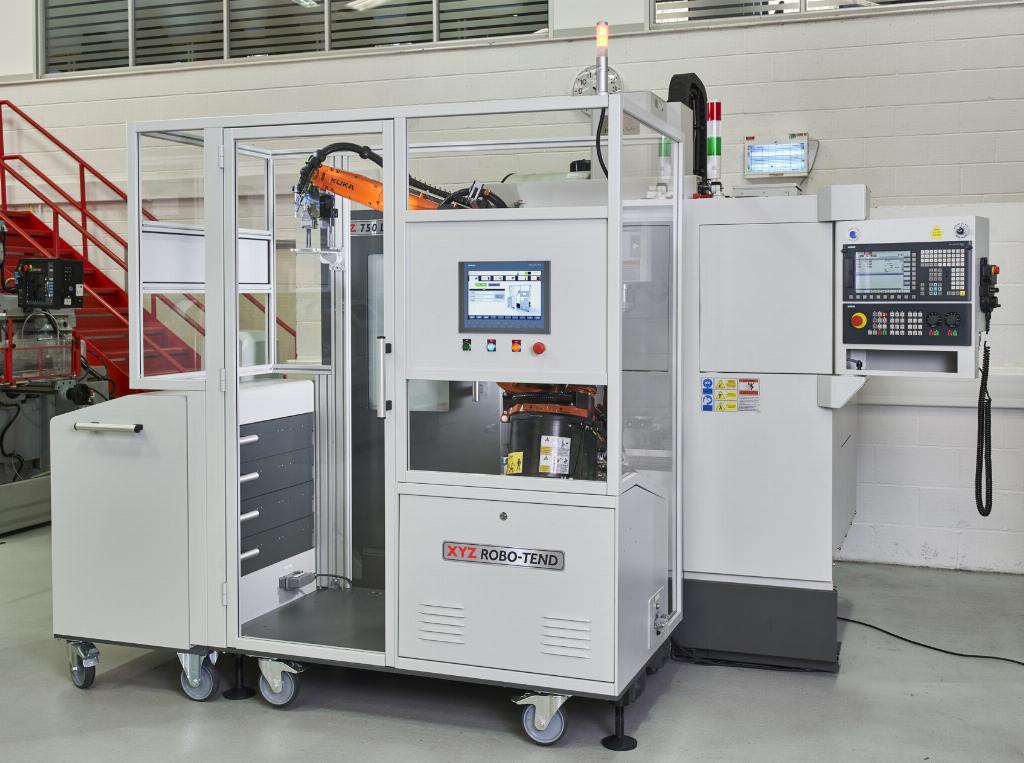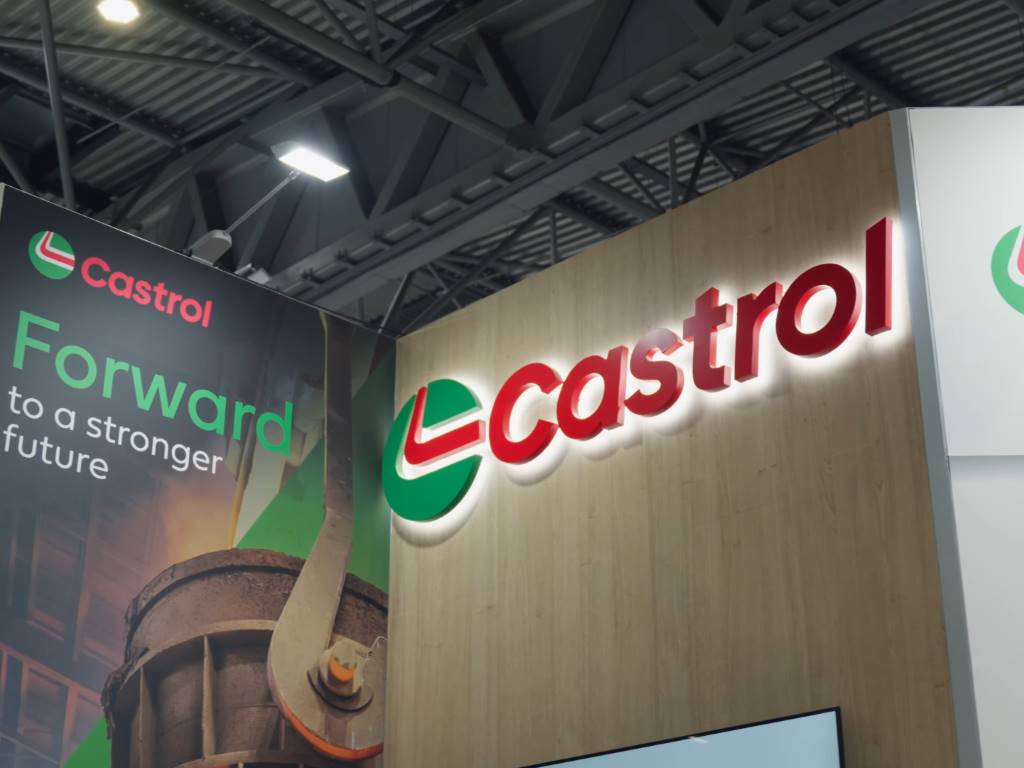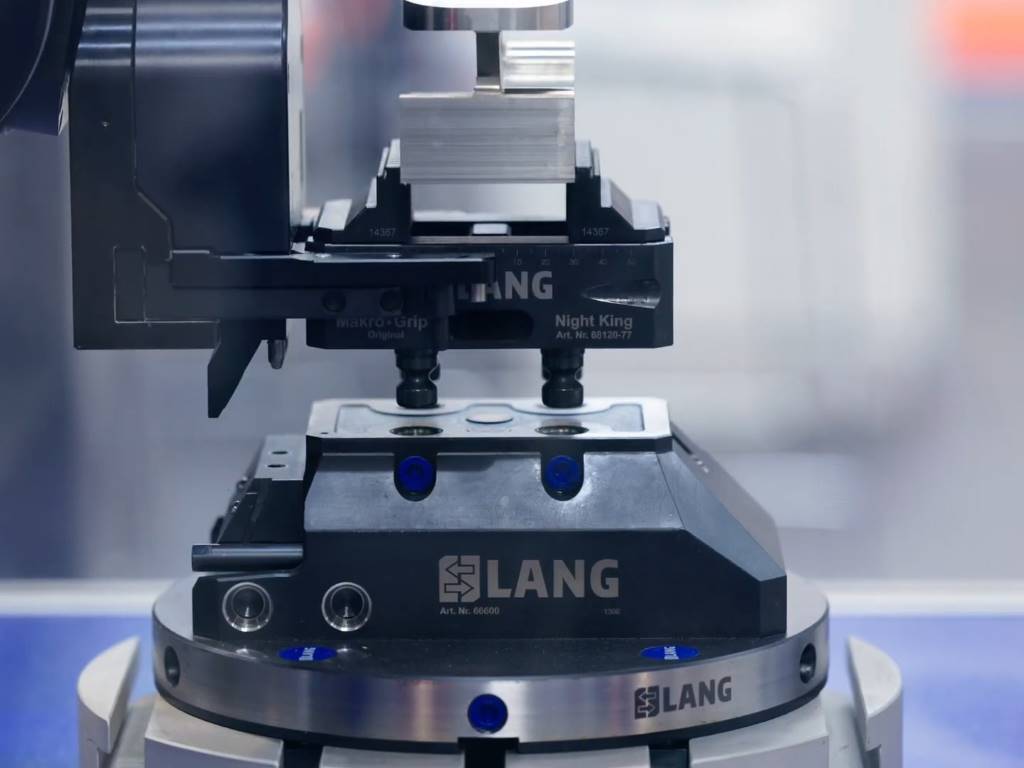Embracing automation: can you afford not to?

Visitors to XYZ Machine Tools’ stand at MACH 2018 would have seen the company’s first foray into robot-based machine tending. Now two years later, following a period of frenetic re-development, refining and improvement, the latest incarnation of Robo-Tend is ready to hit the ground running. Dave Tudor took a drive down to XYZ HQ in Burlescombe, Devon for a closer look.
There’s constant pressure on global manufacturing to adopt automation as skills become scarcer and the incessant drive for greater productivity marches on relentlessly.
Unfortunately the UK has been woefully slow even getting out of the starting blocks. Many aspects have contributed to this but the fact remains that the UK is the only G7 country with a robot density below the world’s average – 30% less productive per hour than manufacturers in Germany in fact.
But things are changing. Machine tool companies like XYZ are now introducing highly efficient, cost-effective automated solutions to their portfolio. Automation is here; it’s affordable; and we need to embrace it with open arms.

Introducing an automated machine tending solution to the product range has been incubating in XYZ managing director Nigel Atherton’s mind for several years now. Turning that idea into reality however has been challenging to say the least. Buying a robot is easy; developing and integrating it into a working system is the difficult bit.
“Several years ago we were encouraged by Siemens to look at developing a machine tending system so we spoke to KUKA who offered to provide a robot that we could use in our showroom,” he recalls.
“We were given contact details of a local integrator but things just didn’t work out. Then KUKA suggested getting in touch with Paul Stout and his team at Adelphi Automation in Manchester who have a proven track record in developing and delivering automation solutions for industrial applications. After an initial meeting we realised that Adelphi would be the ideal partner to work with on this project.”
Top drawer
Straight off the bat it’s important to note that Robo-Tend is only currently available for new XYZ Siemens controlled machines – being fully compatible with the ShopMill and ShopTurn controls used on virtually all of the VMCs and turning centres that XYZ sells. Retrofitting options are available however.
Essentially, in its standard configuration, Robo-Tend comprises five main elements: a KUKA Cybertech KR10 R1420 robot with 10kg load capacity (larger capacity robots are available, as are models from other manufacturers if required ); a KUKA KRC4 compact robot controller; a robot trolley; a four-drawer loading trolley for housing raw materials and finished parts; and a vision system.
In terms of options, there’s plenty to choose from including a range of servo or pneumatic grippers, automatic vices, vertical conveyor systems and two-way drawers.
Fundamentally, Robo-Tend is a robot-based automation cell with camera vision system that makes use of fiducial markers on up to four vices on the table of a machining centre along with similar markers in the component storage drawers. This means that positioning of components or vices is not critical for efficient functioning of the system.
Each of the four drawers is capable of holding a maximum of 90kg of material with a maximum billet height of 120mm. With the robot camera vision system identifying the location of the parts in the drawers – which the robot opens and closes automatically – the parts can be loosely placed within the location pins, with the system calculating the actual pick-up point.
Now, with robot and storage units connected, the guards interlock and create a safe working environment for the robot. If access is required to the machine table for setting or maintenance purposes, the robot is positioned in a safe parking position and becomes in-operative, allowing ease of access.

Operational simplicity
Operation is a three-stage process: Wheel it up: the robot trolley is literally wheeled up to the chosen machine tool and locked in position; Lock into position: the four-drawer loading trolley is then securely attached to the robot trolley and the robot identifies the drawer contents. The guard then locks and Robo-Tend becomes live.
Next, Tell it the billet size: rapid set-up with minimal programming via the easy to use conversational KRC4 robot controller, fed with information such as the shape of the billet, material size and number of parts in the drawers.
Interestingly, if you need access to finished components for sample inspection tasks for example or even to load the raw material for a different job while the machine is running – a two-way drawer option is available with Robo-Tend so drawers can be accessed without interrupting and breaking the production cycle.
“We wanted Robo-Tend to be inexpensive, flexible and versatile with the capability of being used on smaller batch sizes,” Mr Atherton adds. “Another important aspect is portability; you can literally move the Robo-Tend system around the shopfloor from machine to machine.”
He continues: “Although the software behind it is complex, operation is simplicity itself: “The robot opens the drawer, takes a component out and loads it into the machine. After op1 it takes the part out, flips it over and completes op 2. Then it removes the finished component, places it back in the drawer and takes the next billet out – and it can accommodate multiple vice set-ups on the machine.”
Putting in a shift
By Nigel Atherton’s own admission, getting Robo-Tend to where it is now development-wise was a much bigger task than originally anticipated: “It’s taken an unbelievable amount of work but we think we’ve nailed it,” he asserts.
“It’s a system that any subcontractor can buy inexpensively. It’s designed from the ground up to be used unmanned in lights out conditions and the various options available mean that Robo-Tend is highly configurable depending on the customer’s application.
“For optimum versatility I can see customers buying two loading trolleys. Whilst the components/billets in each drawer have to be the same, you can have different parts in different drawers. More drawers mean more different parts that can be processed.
“After living and breathing Robo-Tend for what seems like eternity, I’ve realised that productivity-wise, especially with its lights-out capabilities, it’s the equivalent of having an extra shift running. I’d actually go a stage further: there’s no way today that I would have a subcontract engineering machine shop without some kind of robot loading/unloading system in place.”

Automation expertise
As the company responsible for software development and the HMI not to mention facilitating the seamless integration with XYZ’s machining centres, Adelphi – a business well-versed in designing and manufacturing turnkey solutions involving robotics, conveyor systems and materials handling equipment – has undoubtedly been instrumental in bringing Robo-Tend to market.
As managing director Paul Stout reveals, machine tending is something that he initially came across several years ago: “18 months before our first meeting with XYZ, KUKA started talking to us about machine tending; they saw this as a real opportunity and growth area and asked if we’d like to work with them,” he says.
“Then we were introduced to XYZ and things started to happen. We pooled our combined resources, expertise and knowledge and Robo-Tend is the result. We think there’ll be a real appetite for this system and we’re really looking forward to introducing it to the marketplace.
“It’s very much a standardised product but with the inherent flexibility and options available to cater for the vast majority of applications.”

Number crunching
Once you start doing the maths on Robo-Tend, the true economic benefits of automation become crystal clear. Nigel Atherton says that 70% of the machines XYZ sells are through a finance company and he can’t see that trend changing anytime soon with Robo-Tend. With that in mind, let’s do the sums (excluding VAT) over a five year period.
| Robo-Tend cost | £72,000 |
| Deposit | £10,000 |
| Balance to finance | £62,000 |
| Interest at 3% flat per annum over 5 years | £9,300 |
| Total to repay | £71,300 |
Which equates to 60 monthly payments of approximately £1,188 or £14,256 per annum.
We can see that the annual cost of the system alone is highly cost-effective but when you factor in hours worked and different shift patterns things get even more interesting. The 51 week period in the figures below is allowing for a shutdown – perhaps over the Christmas period.
- Single shift, 10 hours per day, 5 days per week for 51 weeks = 2,550 hours per year. The cost of Robo-Tend here is £5.59 per hour (£14,256/2,550)
- Single shift, 10 hours per day, 7 days per week for 51 weeks = 3,570 hours per year. The cost of Robo-Tend here is £4.00 per hour (£14,256/3,570)
- Double shift, 20 hours per day, 5 days per week for 51 weeks = 5,100 hours per year. The cost of Robo-Tend here is £2.79 per hour (£14,256/5,100)
- Double shift, 20 hours per day, 7 days per week for 51 weeks = 7,140 hours per year. The cost of Robo-Tend here is £2.00 per hour (£14,256/7,140)
- 24 hours a day, 7 days per week for 51 weeks = 8,568 hours per year. The cost of Robo-Tend here is £1.66 per hour (£14,256/8,568)
“When you consider that a typical operator – taking pensions, tax and national insurance into account – costs around £16.00/hour this really is a no-brainer,” Mr Atherton enthuses. “Also, Robo-Tend will last longer than five years so you could easily amortise the unit over 10-15 years, effectively more than halving the hourly rates above.
“However I want to emphasise the fact that Robo-Tend isn’t intended to replace human operators. If anything it’ll promote upskilling and the re-deployment of existing staff. Robots excel at mundane, repetitive tasks, freeing people up to do other things.”
It’s hard to argue with that. Robots don’t take holidays, have time off sick, need toilet breaks and can work 24/7. With Robo-Tend, payback can be within a few months if purchased outright and as we’ve seen, even if bought through finance, Robo-Tend, pushed to the max can cost less than £2 per hour. There’s no national insurance and it’s tax deductible.
At your service
Reassuringly, Adelphi and XYZ are offering service level agreements (SLAs) to users of the Robo-Tend system.
“A lot of companies that we deal with who are investing in automation for the first time are quite understandably nervous from an operational and maintenance perspective,” Paul Stout explains. “With this in mind, we’re offering SLAs that will be free for the first year. After that, customers will pay for the levels of service they require.
“Basically we’ll install a remote dialling card into the control system in the first year to offer customers immediate telephone and online support, enabling us to commit to a response time to solve the problem. We’re in the process of establishing formal pricing structures for customers once the first year has elapsed, but the objective is to give clients peace of mind by offering support at whatever level is required.”
XYZ Machine Tools www.xyxmachinetools.com
Adelphi Automation www.adelphiautomation.co.uk














